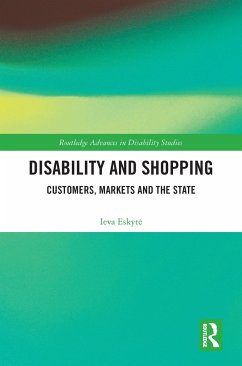- Gebundenes Buch
- Merkliste
- Auf die Merkliste
- Bewerten Bewerten
- Teilen
- Produkt teilen
- Produkterinnerung
- Produkterinnerung
This book provides an examination of the diverse experiences and perspectives of disabled customers, industry and civil society, and how global, regional and national policy instruments should be shaped to increase customer rights and participation.
Andere Kunden interessierten sich auch für
![Tourist Shopping Villages Tourist Shopping Villages]() Laurie MurphyTourist Shopping Villages190,99 €
Laurie MurphyTourist Shopping Villages190,99 €![Tourist Shopping Villages Tourist Shopping Villages]() Laurie MurphyTourist Shopping Villages58,99 €
Laurie MurphyTourist Shopping Villages58,99 €![Why You Buy Why You Buy]() Lorne TeppermanWhy You Buy21,99 €
Lorne TeppermanWhy You Buy21,99 €![Consumer Behavior Essentials You Always Wanted To Know Consumer Behavior Essentials You Always Wanted To Know]() Pablo IbarrecheConsumer Behavior Essentials You Always Wanted To Know66,99 €
Pablo IbarrecheConsumer Behavior Essentials You Always Wanted To Know66,99 €![Consumer Behavior Essentials You Always Wanted To Know Consumer Behavior Essentials You Always Wanted To Know]() Pablo IbarrecheConsumer Behavior Essentials You Always Wanted To Know37,99 €
Pablo IbarrecheConsumer Behavior Essentials You Always Wanted To Know37,99 €![Mystery Shopping Mastery Mystery Shopping Mastery]() Steven D Di PietroMystery Shopping Mastery22,99 €
Steven D Di PietroMystery Shopping Mastery22,99 €![Hunting for Airport Revenue Optimization Hunting for Airport Revenue Optimization]() Sebastian WagnerHunting for Airport Revenue Optimization47,95 €
Sebastian WagnerHunting for Airport Revenue Optimization47,95 €-
-
-
This book provides an examination of the diverse experiences and perspectives of disabled customers, industry and civil society, and how global, regional and national policy instruments should be shaped to increase customer rights and participation.
Produktdetails
- Produktdetails
- Verlag: Routledge
- Seitenzahl: 274
- Erscheinungstermin: 15. Januar 2019
- Englisch
- Abmessung: 240mm x 161mm x 19mm
- Gewicht: 578g
- ISBN-13: 9781138105775
- ISBN-10: 1138105775
- Artikelnr.: 55044885
- Herstellerkennzeichnung
- Libri GmbH
- Europaallee 1
- 36244 Bad Hersfeld
- gpsr@libri.de
- Verlag: Routledge
- Seitenzahl: 274
- Erscheinungstermin: 15. Januar 2019
- Englisch
- Abmessung: 240mm x 161mm x 19mm
- Gewicht: 578g
- ISBN-13: 9781138105775
- ISBN-10: 1138105775
- Artikelnr.: 55044885
- Herstellerkennzeichnung
- Libri GmbH
- Europaallee 1
- 36244 Bad Hersfeld
- gpsr@libri.de
Ieva Eskyt¿ is post-doctoral research fellow in the School of Law at the University of Leeds, UK.
List of figures
Acknowledgements
List of abbreviations
Introduction
Conceptual perspectives
Models of disability
Communicative action theory
Research and data generation strategies
Research strategy and key research questions
Why Lithuania and the United Kingdom?
Policy framework
Mystery shopping
Discussing shopping experience - interviews with customers
Studying business and civil society's perspectives
Analysing the data
Structure of the book
Bibliography
Chapter 1: Disabled people in the market
Disabled people and markets: historical insights and current practice
Useless eaters
Passive service users
From consumers to producers: example of direct payments
A target for new business
Vulnerable consumers
Shopping chain and disabled customers
Customer information
Navigation in retail premises
Interaction in the shop
Accessibility and the private market
Accessibility and user involvement
Accessibility and a common language
Universal design and retail premises
Concluding comments
Bibliography
Chapter 2: Accessibility in the EU markets
Accessibility in the global context
Accessibility and the CRPD
Accessibility in the European single market
Disabled customers
Information provision
Accessibility of retail premises
Accessibility in national markets: Lithuania and the UK
'Socially vulnerable' consumers in Lithuania
'Vulnerable consumers' in the UK
Accessibility in Lithuania
Accessibility in the UK
Concluding comments
Bibliography
Chapter 3: Communicative action and the EU markets
Market accessibility and a lifeworld
'System' and 'lifeworld'
EU policies and the lifeworld
Large business, SMEs and the lifeworld
Private market, customers and the lifeworld
Access to the discourse and power relations
Communicative action
Bargaining and arguing
Bargaining, arguing and international relations
Communicative rationality and Open Method of Coordination
Concluding comments
Bibliography
Chapter 4: The chain of an accessible shopping
Customer information
Information about shops
Information about products
Information about product accessibility
The journey to a shop
Home environment
Public environment
Public and private transport
Navigation in retail premises
Entering the shop
Operating in retail premises
Reaching products
Interaction in the shop
Interaction with informal assistants
Interaction with shop assistants
Interaction with 'special' shop assistants
Concluding comments
Bibliography
Chapter 5: The lifeworld of accessible markets
Notions of disabled customers and accessibility
International business and civil society's perspectives on disabled customers
National business' perspectives on disabled customers
National civil society's perspectives on disabled customers
International stakeholders' perspectives on accessibility
National stakeholders' perspectives on accessibility
The role of policy discourse
Global regulations
EU instruments
National policies
The role of business practice
Accessibility, expenditures and profit
Corporate social responsibility
Product accessibility information
Trainings
Concluding comments
Bibliography
Chapter 6: Access to the discourse and power relations
Formulating the discourse: internal processes
Stakeholder position: international perspectives
Stakeholder position: national perspectives
Stakeholder position and disabled customers
Formulating the discourse: public sphere
Communication and a common goal
Communication and strategic goals
Communication and awareness
Concluding comments
Bibliography
Chapter 7: Summary and conclusions
Book overview
What are the experiences of disabled people as customers in the mainstream private retail markets and their perspectives towards accessibility?
How do stakeholders of the European single market for information and communication technology products perceive disabled people as customers, and what factors shape their knowledge and positions?
How do private business and civil society engage into communication and collaborative innovation to create accessible EU single market and facilitate disabled customers participation?
Way forward
Bibliography
Index
Acknowledgements
List of abbreviations
Introduction
Conceptual perspectives
Models of disability
Communicative action theory
Research and data generation strategies
Research strategy and key research questions
Why Lithuania and the United Kingdom?
Policy framework
Mystery shopping
Discussing shopping experience - interviews with customers
Studying business and civil society's perspectives
Analysing the data
Structure of the book
Bibliography
Chapter 1: Disabled people in the market
Disabled people and markets: historical insights and current practice
Useless eaters
Passive service users
From consumers to producers: example of direct payments
A target for new business
Vulnerable consumers
Shopping chain and disabled customers
Customer information
Navigation in retail premises
Interaction in the shop
Accessibility and the private market
Accessibility and user involvement
Accessibility and a common language
Universal design and retail premises
Concluding comments
Bibliography
Chapter 2: Accessibility in the EU markets
Accessibility in the global context
Accessibility and the CRPD
Accessibility in the European single market
Disabled customers
Information provision
Accessibility of retail premises
Accessibility in national markets: Lithuania and the UK
'Socially vulnerable' consumers in Lithuania
'Vulnerable consumers' in the UK
Accessibility in Lithuania
Accessibility in the UK
Concluding comments
Bibliography
Chapter 3: Communicative action and the EU markets
Market accessibility and a lifeworld
'System' and 'lifeworld'
EU policies and the lifeworld
Large business, SMEs and the lifeworld
Private market, customers and the lifeworld
Access to the discourse and power relations
Communicative action
Bargaining and arguing
Bargaining, arguing and international relations
Communicative rationality and Open Method of Coordination
Concluding comments
Bibliography
Chapter 4: The chain of an accessible shopping
Customer information
Information about shops
Information about products
Information about product accessibility
The journey to a shop
Home environment
Public environment
Public and private transport
Navigation in retail premises
Entering the shop
Operating in retail premises
Reaching products
Interaction in the shop
Interaction with informal assistants
Interaction with shop assistants
Interaction with 'special' shop assistants
Concluding comments
Bibliography
Chapter 5: The lifeworld of accessible markets
Notions of disabled customers and accessibility
International business and civil society's perspectives on disabled customers
National business' perspectives on disabled customers
National civil society's perspectives on disabled customers
International stakeholders' perspectives on accessibility
National stakeholders' perspectives on accessibility
The role of policy discourse
Global regulations
EU instruments
National policies
The role of business practice
Accessibility, expenditures and profit
Corporate social responsibility
Product accessibility information
Trainings
Concluding comments
Bibliography
Chapter 6: Access to the discourse and power relations
Formulating the discourse: internal processes
Stakeholder position: international perspectives
Stakeholder position: national perspectives
Stakeholder position and disabled customers
Formulating the discourse: public sphere
Communication and a common goal
Communication and strategic goals
Communication and awareness
Concluding comments
Bibliography
Chapter 7: Summary and conclusions
Book overview
What are the experiences of disabled people as customers in the mainstream private retail markets and their perspectives towards accessibility?
How do stakeholders of the European single market for information and communication technology products perceive disabled people as customers, and what factors shape their knowledge and positions?
How do private business and civil society engage into communication and collaborative innovation to create accessible EU single market and facilitate disabled customers participation?
Way forward
Bibliography
Index
List of figures
Acknowledgements
List of abbreviations
Introduction
Conceptual perspectives
Models of disability
Communicative action theory
Research and data generation strategies
Research strategy and key research questions
Why Lithuania and the United Kingdom?
Policy framework
Mystery shopping
Discussing shopping experience - interviews with customers
Studying business and civil society's perspectives
Analysing the data
Structure of the book
Bibliography
Chapter 1: Disabled people in the market
Disabled people and markets: historical insights and current practice
Useless eaters
Passive service users
From consumers to producers: example of direct payments
A target for new business
Vulnerable consumers
Shopping chain and disabled customers
Customer information
Navigation in retail premises
Interaction in the shop
Accessibility and the private market
Accessibility and user involvement
Accessibility and a common language
Universal design and retail premises
Concluding comments
Bibliography
Chapter 2: Accessibility in the EU markets
Accessibility in the global context
Accessibility and the CRPD
Accessibility in the European single market
Disabled customers
Information provision
Accessibility of retail premises
Accessibility in national markets: Lithuania and the UK
'Socially vulnerable' consumers in Lithuania
'Vulnerable consumers' in the UK
Accessibility in Lithuania
Accessibility in the UK
Concluding comments
Bibliography
Chapter 3: Communicative action and the EU markets
Market accessibility and a lifeworld
'System' and 'lifeworld'
EU policies and the lifeworld
Large business, SMEs and the lifeworld
Private market, customers and the lifeworld
Access to the discourse and power relations
Communicative action
Bargaining and arguing
Bargaining, arguing and international relations
Communicative rationality and Open Method of Coordination
Concluding comments
Bibliography
Chapter 4: The chain of an accessible shopping
Customer information
Information about shops
Information about products
Information about product accessibility
The journey to a shop
Home environment
Public environment
Public and private transport
Navigation in retail premises
Entering the shop
Operating in retail premises
Reaching products
Interaction in the shop
Interaction with informal assistants
Interaction with shop assistants
Interaction with 'special' shop assistants
Concluding comments
Bibliography
Chapter 5: The lifeworld of accessible markets
Notions of disabled customers and accessibility
International business and civil society's perspectives on disabled customers
National business' perspectives on disabled customers
National civil society's perspectives on disabled customers
International stakeholders' perspectives on accessibility
National stakeholders' perspectives on accessibility
The role of policy discourse
Global regulations
EU instruments
National policies
The role of business practice
Accessibility, expenditures and profit
Corporate social responsibility
Product accessibility information
Trainings
Concluding comments
Bibliography
Chapter 6: Access to the discourse and power relations
Formulating the discourse: internal processes
Stakeholder position: international perspectives
Stakeholder position: national perspectives
Stakeholder position and disabled customers
Formulating the discourse: public sphere
Communication and a common goal
Communication and strategic goals
Communication and awareness
Concluding comments
Bibliography
Chapter 7: Summary and conclusions
Book overview
What are the experiences of disabled people as customers in the mainstream private retail markets and their perspectives towards accessibility?
How do stakeholders of the European single market for information and communication technology products perceive disabled people as customers, and what factors shape their knowledge and positions?
How do private business and civil society engage into communication and collaborative innovation to create accessible EU single market and facilitate disabled customers participation?
Way forward
Bibliography
Index
Acknowledgements
List of abbreviations
Introduction
Conceptual perspectives
Models of disability
Communicative action theory
Research and data generation strategies
Research strategy and key research questions
Why Lithuania and the United Kingdom?
Policy framework
Mystery shopping
Discussing shopping experience - interviews with customers
Studying business and civil society's perspectives
Analysing the data
Structure of the book
Bibliography
Chapter 1: Disabled people in the market
Disabled people and markets: historical insights and current practice
Useless eaters
Passive service users
From consumers to producers: example of direct payments
A target for new business
Vulnerable consumers
Shopping chain and disabled customers
Customer information
Navigation in retail premises
Interaction in the shop
Accessibility and the private market
Accessibility and user involvement
Accessibility and a common language
Universal design and retail premises
Concluding comments
Bibliography
Chapter 2: Accessibility in the EU markets
Accessibility in the global context
Accessibility and the CRPD
Accessibility in the European single market
Disabled customers
Information provision
Accessibility of retail premises
Accessibility in national markets: Lithuania and the UK
'Socially vulnerable' consumers in Lithuania
'Vulnerable consumers' in the UK
Accessibility in Lithuania
Accessibility in the UK
Concluding comments
Bibliography
Chapter 3: Communicative action and the EU markets
Market accessibility and a lifeworld
'System' and 'lifeworld'
EU policies and the lifeworld
Large business, SMEs and the lifeworld
Private market, customers and the lifeworld
Access to the discourse and power relations
Communicative action
Bargaining and arguing
Bargaining, arguing and international relations
Communicative rationality and Open Method of Coordination
Concluding comments
Bibliography
Chapter 4: The chain of an accessible shopping
Customer information
Information about shops
Information about products
Information about product accessibility
The journey to a shop
Home environment
Public environment
Public and private transport
Navigation in retail premises
Entering the shop
Operating in retail premises
Reaching products
Interaction in the shop
Interaction with informal assistants
Interaction with shop assistants
Interaction with 'special' shop assistants
Concluding comments
Bibliography
Chapter 5: The lifeworld of accessible markets
Notions of disabled customers and accessibility
International business and civil society's perspectives on disabled customers
National business' perspectives on disabled customers
National civil society's perspectives on disabled customers
International stakeholders' perspectives on accessibility
National stakeholders' perspectives on accessibility
The role of policy discourse
Global regulations
EU instruments
National policies
The role of business practice
Accessibility, expenditures and profit
Corporate social responsibility
Product accessibility information
Trainings
Concluding comments
Bibliography
Chapter 6: Access to the discourse and power relations
Formulating the discourse: internal processes
Stakeholder position: international perspectives
Stakeholder position: national perspectives
Stakeholder position and disabled customers
Formulating the discourse: public sphere
Communication and a common goal
Communication and strategic goals
Communication and awareness
Concluding comments
Bibliography
Chapter 7: Summary and conclusions
Book overview
What are the experiences of disabled people as customers in the mainstream private retail markets and their perspectives towards accessibility?
How do stakeholders of the European single market for information and communication technology products perceive disabled people as customers, and what factors shape their knowledge and positions?
How do private business and civil society engage into communication and collaborative innovation to create accessible EU single market and facilitate disabled customers participation?
Way forward
Bibliography
Index








